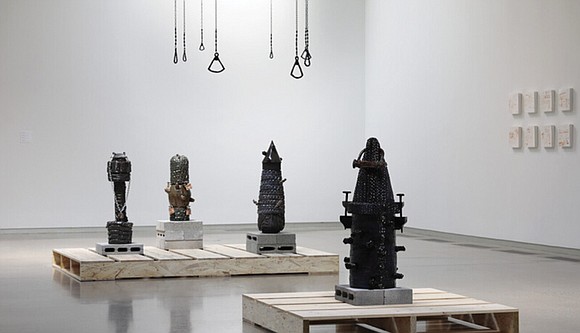ICA exhibit explores race, class and gender
Jennifer Robinson | 3/21/2024, 6 p.m.

Artist Patrice Renee Washington isn’t interested in mainstreaming her creative talents to fit into the white-dominated spaces of the commercial art world. Instead, she focuses on exploring the roots behind racial identity. She’s the artist behind “Tendril,” a solo exhibition of her works at the Institute for Contemporary Art at VCU (ICA at VCU).
African-Americans and other people of color have long used code-switching -adjusting one’s normal behavior to fit into a particular environment—to navigate interracial interactions, typically in the workplace. Unfortunately, code-switching can be exhausting and potentially stifling, especially for creatives. Ms. Washington is intentional about creating and framing her work on her terms.
“It’s a conscious choice not to hide my blackness, and it makes sense to be out about it,” Ms. Washington explains. “It’s more comfortable when you don’t have to hide your blackness. It makes the art easier.”
According to Ms. Washington, a ceramics class at Columbia University changed her life while she pursued her master’s. It set her on a course to work with clay. Although the professor’s teaching style resonated and inspired her, she struggled to create nuanced pieces that suited her African-American narrative in the Ivy League’s white-dominated space. Engaging with other black students fueled a desire to be authentic with her work.
“It’s exhausting trying to create nuances with my pieces to fit into those white-dominated spaces in the art world to make them more comfortable with the work I do,” says Ms. Washington.
Her determination to explore her African-American experiences in her work rather than code-switching has not hindered her career. Her extensive résumé includes solo exhibitions at notable galleries throughout the U.S., and many group exhibitions.
Ms. Washington creates a body of work by taking an idea or theme and investigating structures of race, class, and gender while also considering how identity can be manipulated and shaped to achieve different ends.
In “Tendril,” she threads together different bodies of her work, each revealing how different meanings connect to form cultural symbols. Inspired by the slender, thread-like appendages referred to as tendrils, the exhibit’s title takes on a more significant meaning. Through her work in clay, Ms. Washington reveals the complexities of cultural symbolism.
“Clay withstands the test of time,” Ms. Washington says. “It has a permanence."
Ms. Washington wants us to see how identities are defined through objects that have persisted through history and across continents to converge in the complex cultural symbols she creates with clay. Free-standing ceramic vessels pay tribute to historical Central African nkisi sculptures— hollowed figures filled with medicinal herbs and sacred substances to empower them to protect people and communities.








